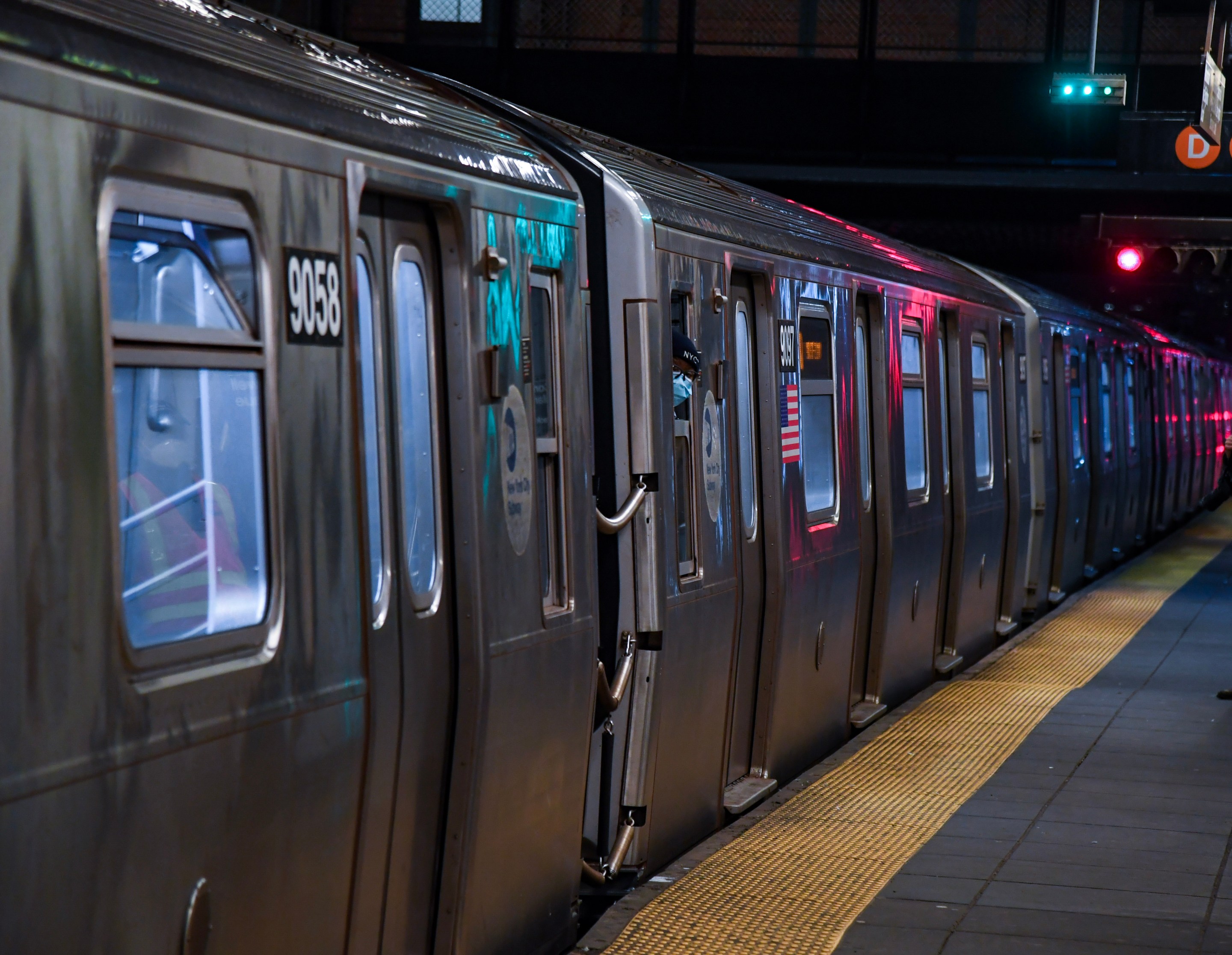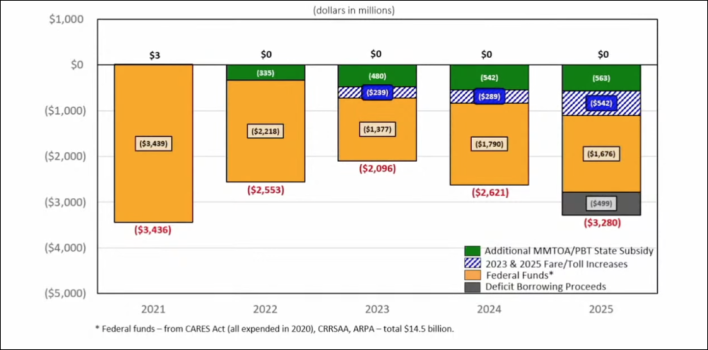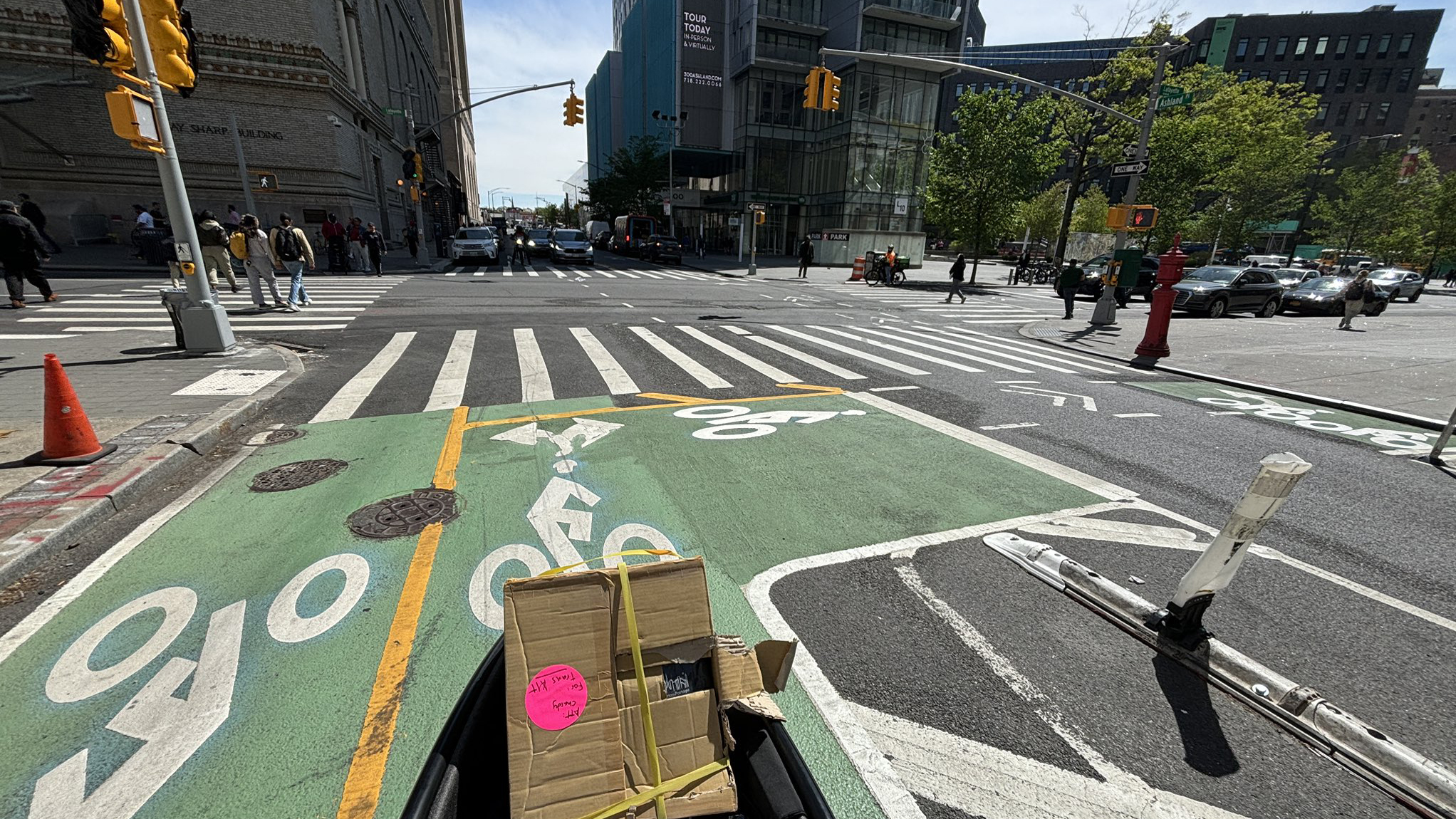Nausea: The MTA Is Facing An Existential Crisis, Again
7:38 AM EDT on July 21, 2022

Night falls on the MTA, and its financial future.
Photo: Marc A. Hermann / MTA New York City Transit
Advertisement: Used Dutch Bikes is your one-stop-shop for authentic Dutch bicycles. Choose from classic “grandma bikes” to modern seven-speeds that can haul three kids without breaking a sweat. We carry authentic brands like Gazelle, Batavus, BSP, Burgers, Cortina, and more — available in the USA for the first time!
Is this the way subway ends, not with a bang but with a whimper?
With mass transit a stranger to so many former regular riders because Rosencrantz and Guildenstern keep working from home, the MTA is facing another existential crisis that is forcing it to figure out another way of being. No it's not the crisis you remember from a couple years ago, this is a new one.
Ridership across the subways, buses and commuter trains is still around 60 percent, which is below even the worst case scenario for summer 2022 that soothsayers McKinsey and Co. predicted back in 2020 when they tried to game out post-pandemic ridership. The low ridership means that the MTA's fare-dependent budget that was already forecasting a half of a billion dollar deficit in 2025 could start leaking before then.
The torrent of bad news conjures visions of the last MTA crisis, when the agency suggested doomsday cuts were the only way to balance its budget if federal aid didn't come through. Into the fear void has stepped state Comptroller Tom DiNapoli, with suggestions that the MTA doesn't actually have to cut service to find its footing, and instead has to get creative with service patterns and get serious with riders about what new service could look like.
DiNapoli's report didn't make hard and fast recommendations about how the MTA should run its trains and buses, but did say the agency could run more of them rather than replicate a 2009-style service cut that included hundreds of layoffs, reduction or elimination of dozens of bus routes, shortening the G train and, at the time, the total elimination of the W and Z trains.
"Adjusting service to identify cost savings is often made in the form of reductions to service," DiNapoli wrote in new report with the mouthful of a title, “Existential Questions Facing National Public Transit Systems Create New Fiscal Pressures for MTA.” "However, as an example, the MTA may be able to generate cost efficiencies by increasing the number of trains per hour which may help to improve its farebox operating revenues by adding service to meet greater demand outside of Manhattan, or at different times of day or of the week." (Emphasis ours.)
The comptroller specifically said that the MTA may also have to look at realigning its service patterns to meet riders where they are, during off-peak and weekend hours, which riders have come back in proportions closer to the before times. On weekends for instance, subway ridership averaged 69 percent of pre-pandemic numbers in June compared to 59 percent on weekdays, which DiNapoli said is a hint that MTA should take about when people are trying to get around.
"If sustained shifts to office commuting and greater demand for off-peak service continue, the MTA may be able to identify opportunities to provide service that is better aligned with new demand, while potentially generating cost efficiencies and creating savings," he wrote.
MTA leadership has so far been reluctant to embrace any kind of big change to its current service patterns that emphasize higher service during rush hour weekdays and a combination of less service and more capital work on weekends. In April, MTA Chairman and CEO Janno Lieber said that he would look into whether there was anything to be done on that issue, but there have been no advances on the horizon since then. In June, New York City Transit President Richard Davey said that the pondering was continuing.
"On nights and weekends and I would even say Mondays and Fridays, we are taking a fresher look at the service," said Davey. "We're seeing ridership at least in the subways, and certainly the bus too, be softer on Mondays and Fridays. So I think for us a question which we haven't really answered yet is should we be offering something other than night, weekend and weekday service? Should there be a hybrid, for example, on Mondays and Fridays?"
DiNapoli's report points out that the MTA isn't alone in its budget problems or its inability to regain all of its pre-pandemic riders, an issue facing transit systems in backwaters like Chicago, Washington DC, Boston and Los Angeles. But the MTA's service is also an outsized economic and equity force compared to those other cities, which is why DiNapoli notes it's so important to get the agency's finances right.
"The use of public transit in New York City fosters foot traffic and economic activity in and around travel hubs, neighborhood stations and bus stops. Public transit also effectively improves the affordability of living in New York City by reducing the need for a vehicle — the city’s car ownership rates are among the lowest for all major metropolitan areas in the country," the report says.
By now, the entire mass transit system was supposed to have recovered between 88 percent of its ridership at best and 76 percent of it at worst. Instead, as The LIRR Today lays out in a series of very distressing charts, total ridership across the transit system is still just about 60 percent of what it was before the pandemic, which is a whopping 22 percent below the agency was expecting it to be.
MTA encountering a bit of an early summer ridership slump compared to 2019, though last week was a little bit better.
— The LIRR Today (@TheLIRRToday) July 20, 2022
The MTA is now missing its ridership projections by 22.7% through the first half of July, the most significant departure yet. Not good for the budget! @2AvSagas pic.twitter.com/FxrbvfwVfo
As life has returned to something approaching vaguely sort of normal through 2021 and 2022, office attendance across the city has still barely broken 40 percent on average. Without a steady stream of daily commuters, subway ridership has regularly been between three million and three and a half million riders per weekday, bus ridership has been topping out below one and a half million per day and commuter railroads haven't been able to break 200,000 weekday riders on the Long Island Rail Road or Metro-North.
The gap between expected ridership and our horrible reality has also meant that the assumptions the MTA made about its future finances, and the way that it's used billions of dollars in federal aid to plug fiscal holes, are way out of date and could force the agency to speed up its lobbying push to get more state funding under the argument that mass transit is an essential service on par with things like the fire department or trash pickup. This chart from November 2021, for instance, showing a yawning a half-billion dollar deficit in beginning in 2025, is at this point as worthless as a promise from Joe Manchin.

The transit agency has known about this uncoupling between its projections and reality for months now. Lieber said in April that McKinsey won a new contract to take another big look at the future, and in May, agency CFO Kevin Willens admitted that the federal aid the MTA was using to float itself through to 2025 might run out before the target date. The new McKinsey ridership projections are supposed to be revealed at the MTA Board meeting in July.
One way or the other though, DiNapoli said that the current mess at the agency is going to need a healthy dose of public facing decision making in order to keep New Yorkers from getting totally bushwacked by whatever changes may be coming down the tunnel, because without federal aid the MTA could be looking at a $2-billion deficit by 2026.
"The MTA needs to lay out what is at stake and explain to the public what options it’s considering to close budget gaps and how it can adjust to continued low ridership levels and shift service to meet changes in demand," said DiNapoli.
For its part, the MTA isn't sweating the report. An agency spokesperson said he agreed with DiNapoli's point about the essential nature of mass transit, and that agency leaders have already been working on fixing some of the fiscal issues, so let's all just chill out.
"The comptroller’s report is consistent with what the MTA has said since the pandemic started: mass transit is an essential service for New Yorkers, and the MTA has begun working with decision makers to develop a plan that assures continued strong mass transit in the post-COVID era," said MTA Chief External Relations John McCarthy. "The MTA will have more to say about its finances when the preliminary 2023 budget and four-year financial plan are presented to the MTA Board at its July meetings."
Dave Colon is a reporter from Long Beach, a barrier island off of the coast of Long Island that you can bike to from the city. It’s a real nice ride. He’s previously been the editor of Brokelyn, a reporter at Gothamist, a freelance reporter and delivered freshly baked bread by bike. Dave is on Twitter as @davecolon. Email Dave Colon at dcolon@streetsblog.org
Read More:
Stay in touch
Sign up for our free newsletter
More from Streetsblog New York City
DOT Aims to Build First Ave. Tunnel Bike Lane Before September’s UN General Assembly
DOT hopes to have the concrete-protect tunnel bike lane installed this summer, but its exact plans are still in development.
Waste Reforms Could Require Data on Crashes, Dangerous Driving
The proposal affects at least one trucking company with a deadly driving record.
When it Comes to Federal Infrastructure Grants, Size Does Matter
Cities and municipalities with larger budgets and staff are more likely to win competitive federal infrastructure grants, the Urban Institute has found.
Tuesday’s Headlines: Real Estate Greed Against Good Bike Lane Design Edition
A real estate developer's opposition to the Ashland Place protected bike lane yields some baffling bike lane markings. Plus more news.
City Considers Fixes for Another Ridiculously Slow Cross-Bronx Bus
Potential bus improvements are on the table for the Bronx's Tremont Avenue, but the Adams administration's failures on nearby Fordham Road loom large.




